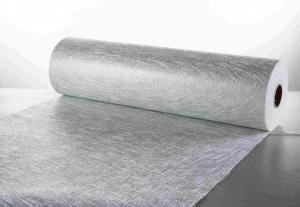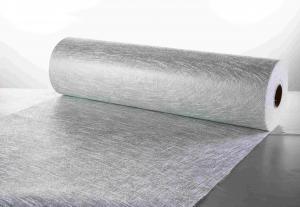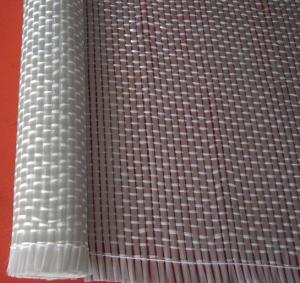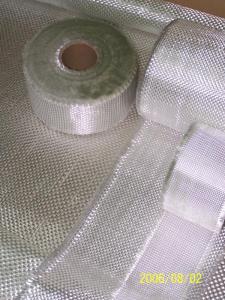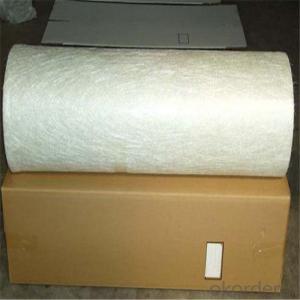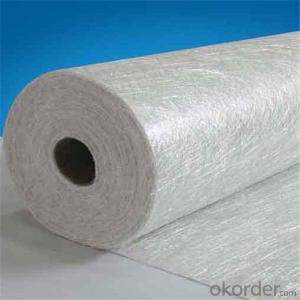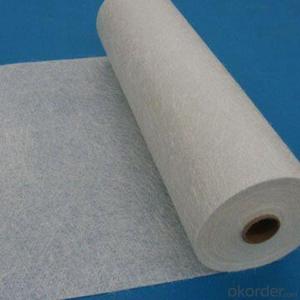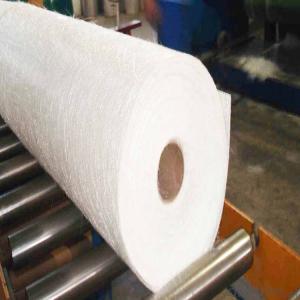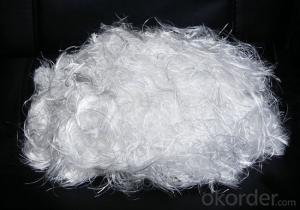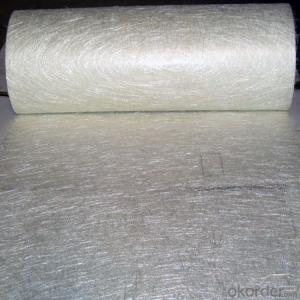E20 Emulsion E Glass Fiber Chopped Strand Mat
- Loading Port:
- Shanghai
- Payment Terms:
- TT or LC
- Min Order Qty:
- 560 kg
- Supply Capability:
- 10000000 kg/month
OKorder Service Pledge
OKorder Financial Service
You Might Also Like
E20 Emulsion Chopped Strand Mat
E20 Emulsion Chopped Strand Mat is made of randomly distributed chopped E6 glass strands held together by an emulsion binder. E20 is suitable to reinforce unsaturated polyester, vinyl ester,epoxy and phenolic resins.
E20 is designed mainly for use in the hand lay-up process and also suitable for use in filament winding and continuous laminating processes. Its end-use applications include boats, bath equipment, automotive parts, chemical corrosion resistant pipes, tanks, cooling towers and building components.
Product Features:
◎ Good conformability.
◎ Good wet-through and fast wet-out in resins, rapid air lease, reducing rolling out time and increasing productivity.
◎ Low resin consumption.
◎ High mechanical strength of parts.
◎ Superior acid corrosion resistance.
Product Specifications:
Property | Area Weight(g/m²) | Moisture Content(%) | Size Content(%) | Breakage Strength(N) |
Methods | ISO 3374 | ISO 3344 | ISO 1887 | ISO 3342 |
EMC225 | 225(1±6%) | ≤0.15 | 4.4(1±31%) | ≥80 |
EMC300 | 300(1±6%) | ≤0.15 | 4.0(1±31%) | ≥100 |
EMC375 | 375(1±6%) | ≤0.15 | 3.8(1±31%) | ≥120 |
EMC450 | 450(1±6%) | ≤0.15 | 3.7(1±31%) | ≥140 |
EMC600 | 600(1±6%) | ≤0.15 | 3.5(1±31%) | ≥160 |
EMC900 | 900(1±6%) | ≤0.15 | 3.3(1±31%) | ≥200 |
Packaging:
Each Emulsion Chopped Strand Mat is wound onto a paper tube which has an inside diameter of 90mm. The roll outside diameter is approximately 265mm. Each roll is wrapped up in plastic film and then packed in a cardboard box. The rolls are stacked horizontally or vertically onto pallets. All pallets are stretch wrapped and strapped to maintain stability during transport.
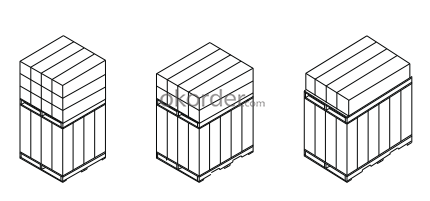
Storage:
Unless otherwise specified, the fiberglass products should be stored in a dry,cool and moisture-proof area. The fiberglass products should remain in their original package until prior to use. The room temperature and humidity should be always maintained at -10℃~35℃ and ≤80% respectively. It is best if the product is used within 6 months after production date.
- Q:How does the fiber volume fraction affect the performance of fiberglass chopped strand?
- The fiber volume fraction refers to the percentage of a composite material that is composed of fibers. In the case of fiberglass chopped strand, increasing the fiber volume fraction has a direct impact on its performance. A higher fiber volume fraction leads to improved mechanical properties of the fiberglass chopped strand. This is because fibers are the primary load-bearing component of the composite material. As the volume fraction of fibers increases, the material's strength, stiffness, and resistance to deformation also increase. This means that the fiberglass chopped strand with a higher fiber volume fraction can withstand higher loads and exhibit enhanced durability and dimensional stability. Additionally, a higher fiber volume fraction improves the interfacial bonding between the fibers and the matrix material in the composite. This results in better load transfer between the fibers and the matrix, leading to increased energy absorption and resistance to cracks or fractures. The improved interfacial bonding also enhances the overall toughness of the fiberglass chopped strand, making it more resistant to impact and fatigue. However, there is a limit to the benefits of increasing the fiber volume fraction. Above a certain point, known as the critical fiber volume fraction, the performance gains become less significant. This is mainly due to the difficulty in achieving a uniform distribution of fibers at very high volume fractions, resulting in an increased likelihood of defects such as voids or clustering. These defects can weaken the material and reduce its overall performance. In conclusion, the fiber volume fraction has a significant impact on the performance of fiberglass chopped strand. Increasing the fiber volume fraction improves the material's mechanical properties, interfacial bonding, and overall toughness. However, there is a limit to the benefits, and careful attention must be paid to achieving a uniform distribution of fibers to avoid detrimental defects.
- Q:How does the fiber dispersion affect the properties of fiberglass chopped strand?
- Fiber dispersion refers to the distribution and alignment of individual fiberglass strands within a chopped strand. It plays a crucial role in determining the properties of fiberglass chopped strand. Proper fiber dispersion ensures uniform reinforcement throughout the composite material, resulting in enhanced strength, stiffness, and impact resistance. It also promotes better resin impregnation, leading to improved adhesion between the fibers and the matrix. In contrast, poor fiber dispersion can result in weak spots, reduced mechanical properties, and potential delamination issues in the finished fiberglass product.
- Q:What are the surface finish options for fiberglass chopped strand?
- The surface finish options for fiberglass chopped strand include smooth, textured, matte, and glossy finishes.
- Q:Can fiberglass chopped strand be used in the production of aerospace interiors?
- Yes, fiberglass chopped strand can be used in the production of aerospace interiors. It is commonly used in applications such as insulation, paneling, and reinforcement for lightweight structures.
- Q:How is fiberglass chopped strand packaged and shipped?
- Fiberglass chopped strand is commonly packaged and shipped in different ways to ensure its safe transportation and handling. The specific packaging and shipping methods vary depending on the manufacturer, customer requirements, and the type of fiberglass chopped strand being shipped. One common packaging method involves placing the chopped strand into cardboard boxes or plastic bags. Care is taken to compress and arrange the chopped strand in these packages to maximize the quantity per package and minimize the risk of damage during transit. The boxes or bags are then sealed to protect the contents from moisture or contaminants. In some instances, fiberglass chopped strand may be packaged in bulk bags or super sacks. These durable polypropylene bags can hold a significant amount of chopped strand, typically ranging from hundreds to thousands of pounds. They often have lifting loops or straps attached for easier handling and loading onto pallets or trucks. Once packaged, the fiberglass chopped strand is loaded onto pallets for shipment. These pallets, made of wood or plastic, are designed to provide stability and protection during transportation. The packages or bulk bags are securely strapped or shrink-wrapped to the pallets to prevent movement or damage. The shipping methods for fiberglass chopped strand depend on the distance and destination. For shorter distances, trucks or vans may be used to transport the palletized packages or bulk bags. For longer distances or international shipments, the chopped strand may be loaded into shipping containers and transported by sea or air freight. To ensure safe delivery, additional protective measures like stretch wrapping, corner protectors, or cushioning materials may be used to minimize the risk of damage caused by vibrations or impacts during transit. In conclusion, the packaging and shipping of fiberglass chopped strand play a vital role in maintaining its structural integrity and quality. These measures also ensure the safe handling and transportation of the product from the manufacturer to the customer.
- Q:What are the safety precautions to be taken while handling fiberglass chopped strand?
- To ensure the safety of individuals when working with fiberglass chopped strand, it is important to take several safety precautions. These precautions include: 1. Wearing the appropriate Personal Protective Equipment (PPE): It is essential to wear safety goggles or a face shield to protect the eyes from loose fibers or particles. Gloves should also be worn to avoid direct contact with the fiberglass, which can cause skin irritation or cuts. Furthermore, it is recommended to wear long-sleeved shirts and pants for added protection. 2. Ensuring proper ventilation: It is advisable to handle fiberglass chopped strand in a well-ventilated area to minimize the inhalation of airborne fibers. If working indoors, open windows and doors or use exhaust fans to promote air circulation. When working outdoors, position yourself upwind to avoid inhaling fiberglass particles. 3. Storing the material correctly: Fiberglass chopped strand should be stored in a secure location away from moisture and direct sunlight. This prevents any potential degradation and ensures its safety for future use. 4. Using careful handling techniques: When handling the material, it is important to be cautious. Avoid dropping or mishandling the fibers to prevent the release of loose particles into the air. Using gloves or specialized tools designed for fiberglass handling can minimize direct contact. 5. Maintaining cleanliness and hygiene: After handling fiberglass chopped strand, it is crucial to thoroughly wash your hands and exposed skin to remove any loose fibers. Additionally, avoid touching your face, eyes, or mouth during the handling process to prevent accidental ingestion or irritation. 6. Proper disposal: To prevent environmental contamination, it is important to dispose of any unused or waste fiberglass chopped strand in accordance with local regulations and guidelines. By adhering to these safety precautions, individuals can minimize the associated risks of handling fiberglass chopped strand and create a safe working environment.
- Q:How does the moisture absorption of the chopped strand affect its performance?
- The performance of chopped strand can be greatly affected by its ability to absorb moisture. Chopped strand, typically composed of glass or carbon fibers, has a tendency to soak up moisture when exposed to damp or wet conditions. This absorption of moisture can result in several negative consequences for its performance. To begin with, the structural integrity of the chopped strand can be weakened by moisture. When the fibers absorb water, they may lose some of their strength and stiffness, compromising the overall performance of the material. This can be a significant concern in applications that require high strength and durability, such as in the aerospace or automotive industries where composite materials are used. Additionally, the absorption of moisture can cause dimensional instability. When the fibers soak up water, they can expand, causing the chopped strand to change in size and shape. This can pose problems in applications where precise dimensions are crucial, leading to issues with fitment or distortion of the final product. Furthermore, the absorption of moisture can also lead to the growth of mold or fungi. Moisture provides an ideal environment for the development of these organisms, which can degrade the fibers and further compromise the performance of the chopped strand. This can be particularly detrimental in applications where the material is exposed to high humidity or moisture for extended periods, such as in marine or outdoor environments. In conclusion, the moisture absorption of chopped strand can have a significant impact on its performance. It can weaken the structural integrity, cause dimensional instability, and promote the growth of mold or fungi. Therefore, it is of utmost importance to consider the moisture absorption characteristics of chopped strand when selecting and using it in various applications.
- Q:What are the UV stability properties of fiberglass chopped strand?
- Fiberglass chopped strand has excellent UV stability properties. UV stability refers to the ability of a material to withstand the damaging effects of ultraviolet (UV) radiation from the sun. Fiberglass, being a composite material made from fine fibers of glass, is highly resistant to UV radiation. The main reason for the good UV stability of fiberglass chopped strand is the composition of the material. Fiberglass is made from glass fibers that are reinforced with a polymer matrix, which provides additional stability and protection against UV radiation. The glass fibers themselves are inherently resistant to UV damage, as glass is not affected by UV radiation in the same way that organic materials are. Furthermore, the polymer matrix used in fiberglass chopped strand is often a thermosetting resin, such as polyester or epoxy. These resins are designed to have excellent UV resistance, ensuring that the material remains stable and does not degrade or deteriorate when exposed to sunlight. In addition to the composition of the material, the manufacturing process also contributes to the UV stability of fiberglass chopped strand. During the manufacturing process, the glass fibers are typically coated with a sizing agent, which further enhances the UV resistance of the material. The sizing agent forms a protective barrier around the glass fibers, shielding them from the harmful effects of UV radiation. Overall, fiberglass chopped strand exhibits excellent UV stability properties, making it a popular choice for various applications that require durability and resistance to outdoor environments. This includes applications such as automotive parts, marine equipment, construction materials, and other products that are exposed to sunlight and UV radiation.
- Q:Is fiberglass chopped strand suitable for sports equipment manufacturing?
- Yes, fiberglass chopped strand is suitable for sports equipment manufacturing. Fiberglass is a lightweight, durable, and strong material that is commonly used in the production of various sports equipment such as boats, kayaks, surfboards, hockey sticks, and helmets. The chopped strand form of fiberglass consists of small glass fibers that are randomly oriented and can be easily mixed with resin to create a composite material. This allows for flexibility and customization in the manufacturing process, as the chopped strand can be easily molded and shaped to meet the specific requirements and design of different sports equipment. Additionally, fiberglass has excellent tensile strength, impact resistance, and dimensional stability, making it an ideal choice for sports equipment that needs to withstand rigorous use and potential impacts.
- Q:What are the dimensional stability properties of fiberglass chopped strand?
- The dimensional stability properties of fiberglass chopped strand refer to its ability to retain its shape and size under various conditions. Fiberglass chopped strand is known for its excellent dimensional stability, meaning it is resistant to shrinking, warping, or expanding when subjected to changes in temperature, humidity, or mechanical stress. This makes it a reliable material for applications where maintaining precise dimensions is crucial.
1. Manufacturer Overview |
|
|---|---|
| Location | |
| Year Established | |
| Annual Output Value | |
| Main Markets | |
| Company Certifications | |
2. Manufacturer Certificates |
|
|---|---|
| a) Certification Name | |
| Range | |
| Reference | |
| Validity Period | |
3. Manufacturer Capability |
|
|---|---|
| a)Trade Capacity | |
| Nearest Port | |
| Export Percentage | |
| No.of Employees in Trade Department | |
| Language Spoken: | |
| b)Factory Information | |
| Factory Size: | |
| No. of Production Lines | |
| Contract Manufacturing | |
| Product Price Range | |
Send your message to us
E20 Emulsion E Glass Fiber Chopped Strand Mat
- Loading Port:
- Shanghai
- Payment Terms:
- TT or LC
- Min Order Qty:
- 560 kg
- Supply Capability:
- 10000000 kg/month
OKorder Service Pledge
OKorder Financial Service
Similar products
New products
Hot products
Hot Searches
Related keywords
